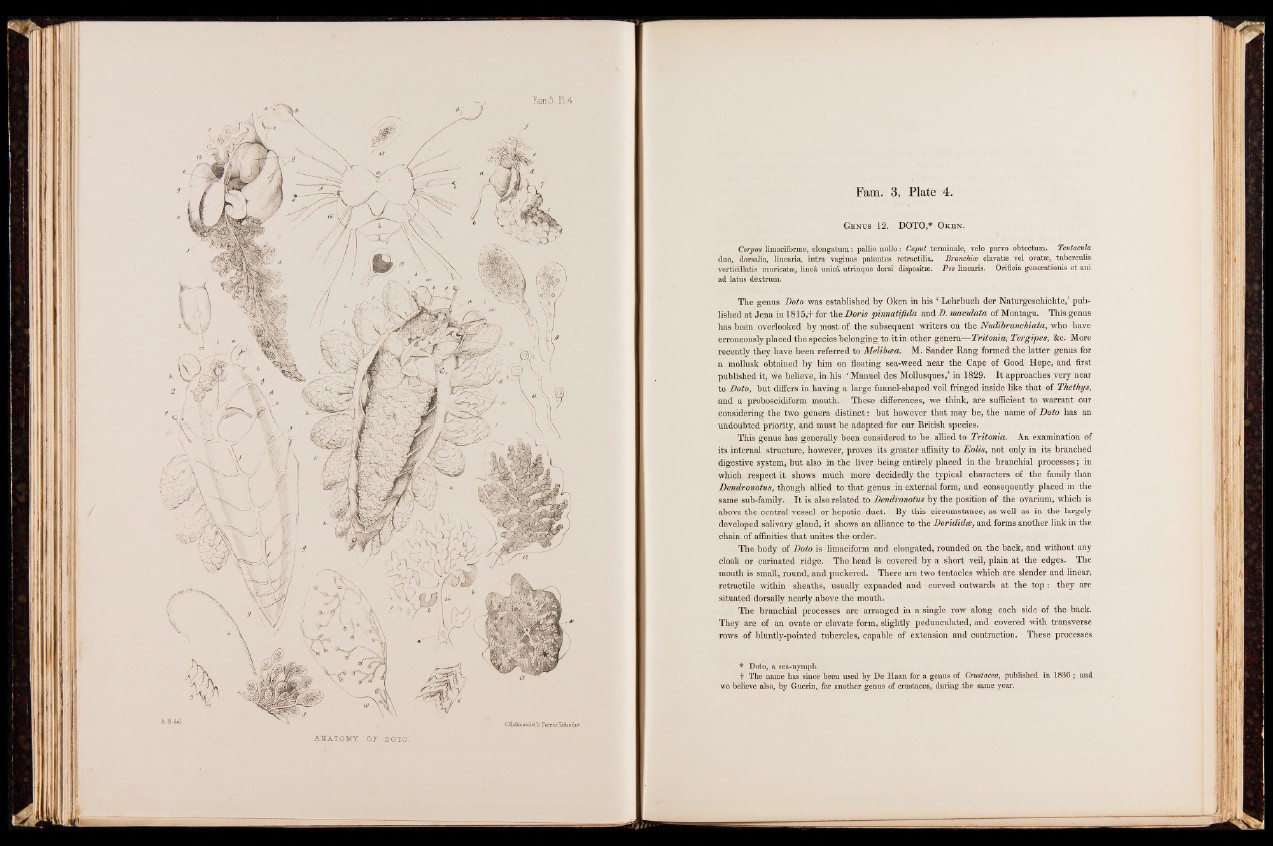
lam-: 3. Tl.4.
ANATOMY OP DO TO.
Genus 12. DOTO,* Oken.
Corpus limaciforme, elongatum: pallio nullo : Caput terminale, velo parvo obtectum. Tentacula
duo, dorsalia, linearia, intra vaginas patentes retractilia. Branchits clavatse vel ovatse, tuberculis
verticillatis muricatse, lined unica utrinque dorsi dispositae. Pes linearis. Orificia generationis et ani
ad latus dextrum.
The genus Doto was established by Oken in his e Lehrbuch der Naturgeschichte,’ published
at Jena in 1815,t for the Doris pinnatijida and D. metadata, of Montagu. This genus
has been overlooked by most of the subsequent writers on the Nudibranchiata, who have
erroneously placed the species belonging to it in other genera— Tritonia, Tergipes, &c. More
recently they havé been referred to Melibcea. M. Sander Rang formed the latter genus for
a mollusk obtained by him on floating sea-weed near the Cape of Good Hope, and first
published it, wé believe, in his ‘Manuel des Mollusques,’ in 1829. It approaches very near
to Doto, but differs in having a large funnel-shaped veil fringed inside like that of Thethys,
and a proboscidiform mouth. These differences, we think, are sufficient to warrant our
considering the two genera distinct: but however that may be, the name of Doto has an
undoubted priority, and must be adopted for our British species.
This genus has generally been considered to be allied to Tritonia. An examination of
its internal structure, however, proves its greater affinity to Eolis, not only in its branched
digestive system, but also in the liver being entirely placed in the branchial processes; in
which respect it shows much more decidedly the typical characters of the family than
Dendronotus, though allied to that genus in external form, and consequently placed in the
same sub-family. It is also related to Dendronotus by the position of the ovarium, which is
above thé central vessel or hepatic duct. By this circumstance, as well as in the largely
developed salivary gland, it shows an alliance to the Dorididee, and forms another link in the
chain of affinities that unites the order.
The body of Doto is limaciform and elongated, rounded on the back, and without any
cloak or carinated ridge. The head is covered by a short veil, plain at the edges. The
mouth is small, round, and puckered. There are two tentacles which are slender and linear,
retractile within sheaths, usually expanded and curved outwards at the top: they are
situated dorsally nearly above the mouth.
The branchial processes are arranged in a single row along each side of the back.
They are of an ovate or clavate form, slightly pedunculated, and covered with transverse
rows of bluntly-pointed tubercles, capable of extension and contraction. These processes
* Doto, a sea-nymph.
t The name has since been used by De Haan for a genus of Crustacea, published in 1836; and
we believe also, by Guerin, for another genus of Crustacea, during the same year.